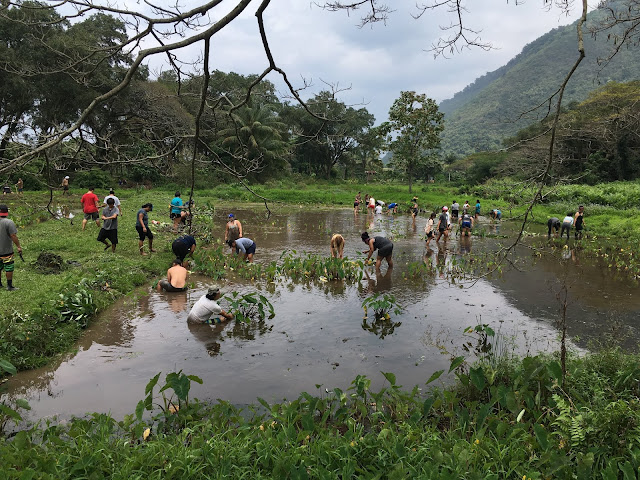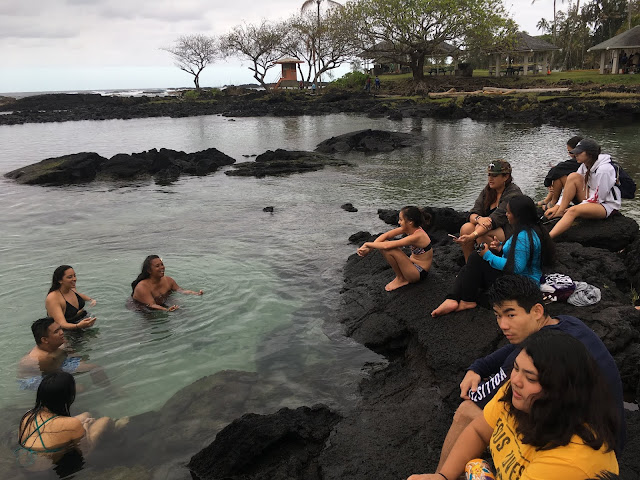For two years in a row, I attended InterVarsity's spring break project on the Big Island (Hawai'i Island) in the town of Hilo. Rachel leads our ISM chapter, International Friends. We brought two different teams, first Sonoe, Risa and Sarah from Japan and Okinawa, and David, who has been raised internationally in a military family and studies Chinese.
Second year, we brought Feng from China and Jikai from Okinawa and Peru. We joined students from five different islands and stayed at our host church, Haili in Hilo.
Haili Church
This historic church is a famous location - maybe not to tourists! But historically, Haili was the center of a 1800s revival and grew to 10,000 members. It was possibly the largest church in the world at the time. The history of Christian missionaries to Hawaii is mixed- many terrible things happened. But also wonderful things happened. Titus Coan was an example of the latter.
The incarnation is expressed so beautifully in John 1:14, "the word became flesh and dwelt among us." This is what Titus Coan attempted to emulate. His love for the people was expressed first by the mastery of the Hawaiian language and secondly by his desire to preach the gospel to everyone living in his district, which was around 15 to 16,000 all living within the distance of 100 miles. In order to preach to everyone, in the fall of 1836 he decided to make a tour on foot of his entire district. - Hawai'i's Great Awakening
Homelani Cemetery
The second year, we made an unusual starting location for learning: a cemetery. The local kupuna (elders) taught us about another important Christian leader, Joseph Nawahi. Nawahi was a native politician during the time of the overthrow. He was a an excellent example of someone maintaining their kanaka (native Hawaiian) identity while deeply following Jesus. (This is in opposition to the historical missionaries who often converted people to white/European/American culture rather than converting them to Jesus.)
From Nawahi, we learn about the lokahi (harmony) triangle. He gave advice to activists who only focused on one aspect rather than the big picture. A believer must:
- Aloha Ke Akua (love God) Matthew 22:37-38
- Aloha Kanaka (love people) John 13:34-35
- Aloha 'Aina (love the land) Psalm 24:1-2
"So now, get three tings dat stay: we can trus God, an we can know everyting goin come out okay bumbye, an we get love an aloha. From da three tings, da love an aloha kine, dass da main ting, an da bestes way." -Numba 1 Fo Da Corint Peopo 13:13
 |
| photo borrowed from Ho'okapili - West Side IV |
Therefore, the man that truly loves a few, will love all, and the man that says he is aloha aina, [love of land] but rejects God - you can say of his man that his love is not real, deep, or true. That is how we recognize people who go around proclaiming publicly with a loud voice their aloha aina, but you can see beneath these false words there is a love that is worthless from these people, these people only have love for man. -Joseph Nawahi
 |
| Studying the Bible in Japanese |
Learning and Serving
Some aloha kanaka at Haili church: learning from the kupuna. These elders have been part of the Hilo community and Haili church for many many years.
We were joined for the week by InterVarsity's regional staff team: some of the upper management from Washington, Oregon and California. These folks were humble and hard-working all week. They laughed when I took a photo of them preparing tomorrow's sandwiches for the students. "You're the fourth person to snap a picture!" they said. Everyone feels encouraged when leaders work as servants.
Aunty Susie also travels to Hawaii every year to manage the kitchen for around 100 students and extended community: a mammoth task! Here, Sabrina is helping her fry spam musubi for lunch.
On community service day, our team worked to serve the church with some aloha 'aina care. We pruned the plants, especially the ti leaves, which have many uses in Hawaiian culture.
and weeded the garden area by the school.
Another year's project was preparing lunch bags to aloha kanaka those living on the streets. Rather than just passing bags out, we brought two lunches, so we could sit to eat together and learn about people's lives. Sonoe was pretty nervous about this project, but working together with friends and making new friends created a good memory for her.
Working in the Lo'i
The big aloha 'aina project for the week is a day working in the lo'i. Like a rice patch, kalo (taro) is planted in a pond.
We travel to Waipi'o Valley, the Valley of the Kings. As a tourist, you can see the entrance and this beautiful vista. We only enter sacred Hawaiian lands with permission. Our kanaka friends remind us, "It's better to go in through the gate then hope over the fence." Our wonderful hosts for this day were Uncle Les and Aunty Renee.
Every year, we clear off all the extra plant life gunking up the pond and also squish the eggs of invasive snails.
Yes, this work involves a lot of bending! But for just one day, the students find it lots of fun. And we keep positive with mele and oli (music and chants).
Then, the kalo can be harvested. First, you break the roots with your foot, pressing down all around the tuber with the side of your foot. Then it's easier to pull the tuber out.
Next the full plant can be harvested!
A worker (not a student) chops off the root, leaving just a little attached to the stalk. We remove the leaves for other purposes and leave a short stalk. Finally, the top stalks are re-planted, so a new tube root will grow.
Waipi'o Valley was cut off from its water source for many years. Farmers in the valley lost their water from the Hiilawe twin falls when the sugar company re-directed the streams that fed them. For over a century, the sugar plantations (a thirsty crop) dominated the water usage on the islands. Only in recent years, the entire sugar industry in Hawaii has slowly shut down, with the last plant finally closing. Activists and educators petitioned to get the streams re-directed back to their original location, and amazingly it was accomplished. Now farmers can return to providing for their families and communities.
Kalo is a staple food in Hawaiian culture, like bread or rice is in others. Any culture with a yam staple will see kalo as familiar.
Kalo leaves and stems can also be used in cooking. The form is an inspiration for much beautiful artwork.
Baptism and Interpretations
During the second year, many came for baptism! Everyone shared a story about why this was important to them. My big role for the week was interpreting for our students. Unfortunately, I don't know any Chinese or Japanese, but I love to practice simplifying a story to make it understandable. (All of our international students are so amazing at English! They understand almost everything if it can be slowed down.)
I also like providing some visual aids. While Jikai and I talked about Elijah and the priests of Baal (see 1 Kings 18), we built a little altar out of rocks at the beach. The story had been shared at the Haili church service that morning, pared with an important Hawaiian story: Kapi'olani defies Pele. (Don't confuse the princess Kapi'olani in this story with the Queen Kapi'olani our community college is named after - two different ladies in different centuries.)
In the Bible story, the prophet Elijah conducted a test as well. He and the wicked priests of the god Baal both asked their gods to set fire to their altars. Baal was unable to perform the miracle, but Elijah's God Jehovah showed the true power.
Justice Issues
We also learned about modern day justice issues faced by locals and Native Hawaiians. One often overlooked issue is how environmental injustices disproportionately affect native and impoverished communities. Hawaii is a major tourist location, and this generates a lot of extra trash and waste. Locals on the Big Island specifically complain about the irresponsible way cruise ships like to empty their sewage near native homes. Those with money have figured out who doesn't have a voice and can easily be ignored. Likewise, the state builds sewage treatment plants, landfills, and other waste facilities near these communities. Thus, tourists get clean beautiful beaches, and people whose families who've been on the land for many generations get the trash.
We had a wonderful dinner at at staff family's home to learn about the Hawaiian Homestead Act, and some of the ongoing problems. The Act was created in 1920, and it has many good intentions. It is meant to provide housing for native Hawaiians on ancestral lands.
The first issue is a math problem: to qualify, a person needs 50% native blood. This can be difficult to prove, especially since there were many decades when natives were ashamed and hide their heritage in an attempt to assimilate. A person with 50% blood can then pass their home on to their 25% blood children, but then if the third generation is no longer at 25%, they lose the land. (Imagine pulling out a calculator as part of your romantic life to calculate the hopes of your future family!)
The second problem is the length of the waiting list. We heard from families whose grandparents have died waiting for a home. (And the suspicious circumstance of the paperwork coming through weeks after a death, when it was too late for anyone in the family to claim the property.) The state also sometimes chooses to give Hawaiian Homestead appointed land to businesses rather the families who are waiting.
This made intuitive sense to international students too, as they understand injustices taking place in their own countries. I'm also grateful to the students from other chapters who are eager to adopt internationals into their friendship circles! It was a good reminder for me that I don't have to be everything for our students.
As always, I am so grateful for this opportunity to learn in Hawaii, from locals and natives who share their wisdom so generously. Thank you for allowing me to be your guest.
You can read more from the links summarized at https://journeyhawaii.wordpress.com/about/ The Hawaii area team did a great job preparing this for students. I found it was great to keep reading after the trip was over.
I have many more photos on Facebook: InterVarsity 17-18, InterVarsity 18-19





































No comments:
Post a Comment